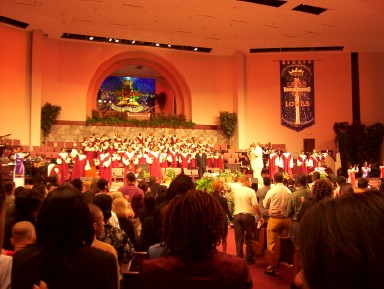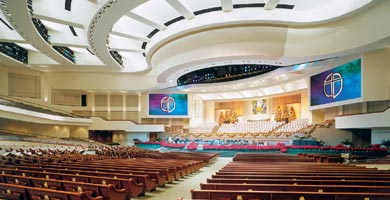 Anyone who knows anything about church growth in America knows that, when it comes to studying big churches, all roads lead to Texas (surprise, surprise) and sooner or later (surprise, surprise) you're going to end up in Dallas, which some people call the capital of American evangelicalism. If you doubt me, click here.
The researchers call them "megachurches." Just how big a church has to be to earn that label is somewhat in dispute. But, suffice it to say, when your church sanctuary seats 2,000-plus you know you're in the right ballpark. If you hit 5,000 you have entered the big leagues. There are so many big churches in Texas that there are even liberal megachurches, including the famous lesbigay friendly Cathedral of Hope.
Anyone who knows anything about church growth in America knows that, when it comes to studying big churches, all roads lead to Texas (surprise, surprise) and sooner or later (surprise, surprise) you're going to end up in Dallas, which some people call the capital of American evangelicalism. If you doubt me, click here.
The researchers call them "megachurches." Just how big a church has to be to earn that label is somewhat in dispute. But, suffice it to say, when your church sanctuary seats 2,000-plus you know you're in the right ballpark. If you hit 5,000 you have entered the big leagues. There are so many big churches in Texas that there are even liberal megachurches, including the famous lesbigay friendly Cathedral of Hope.
But most of the Dallas megachurches are packed with evangelicals, of one stripe or another (although that label is problematic). Dallas is, well, Dallas. There's the famous Potter's House led by the Pentecostal giant Bishop T.D. Jakes and the powerful Oak Cliff Bible Fellowship (photo) led by Dr. Tony Evans. There are huge United Methodist congregations, such as the famous Highland Park United Methodist Church, and cathedrals of various kinds -- Eastern Orthodox, Catholic, Anglican, you name it. Among Southern Baptists there's the old megachurch at First Baptist and the gigantic modern one at Prestonwood (photo number two).
Now, I realize that megachurches are not for everyone. Frankly, they kind of spook me when it comes to atmosphere and architecture. If you want to roam around a bit in the 7,000-seat Prestonwood sanctuary, click here and hang on.
Some people think these places are ugly. But many, many people (including a few who still subscribe to newspapers) think they are the most beautiful places on earth -- modern cathedrals for the age of giant video screens and the worship services that go with them. They are big, dramatic places and I have seen photo essays that -- for better or for worse -- do them justice.
But not this past weekend in the Dallas Morning News.
This is where things get a bit complicated and, if you work in this embattled newspaper's circulation department, a bit depressing.
Year after year, the News wins national awards because of the high quality of its religion coverage. However, there are those who wonder whether this religion-news section is a national section or a local section. This is a question I have raised here at GetReligion. There is no question about the quality of the work. The question is whether the News remains dedicated to covering religion news in the Dallas that most people who live in Dallas would recognize as Dallas.
If you read these pages week after week (as any sane person interested in religion news would), you will read about all kinds of religious groups, and this is good. The problem is that you will find a stunningly low percentage of articles about the changes, trends, problems and triumphs of the largest and most powerful religious groups IN DALLAS.
 This weekend offered a perfect symbolic example of this syndrome, entitled "Sacred Spaces," that probably made some telephones ring at the News. Or, let's put it this way: If this feature did not make the telephones ring, then that would be really bad news. Why? That would tell us how few people in the biggest churches in Dallas still read the Dallas Morning News.
This weekend offered a perfect symbolic example of this syndrome, entitled "Sacred Spaces," that probably made some telephones ring at the News. Or, let's put it this way: If this feature did not make the telephones ring, then that would be really bad news. Why? That would tell us how few people in the biggest churches in Dallas still read the Dallas Morning News.
Here is the prologue to this photo-and-text feature:
What makes a place sacred?
Some -- for instance, Jerusalem -- are sacred because the faithful believe divine manifestations have occurred there. Some religious edifices are imposing, designed and consecrated in accordance with ancient traditions. Sometimes, a simple, quiet spot invites visitors to step out of their routines and into prayer or reflection. And sometimes, tragedy turns ordinary space into hallowed ground -- like Ground Zero in New York, or the John Fitzgerald Kennedy Memorial in downtown Dallas.
We visited seven "sacred spaces" in the greater Dallas area and brought back these images and impressions.
Thus, the News team visited the Cistercian Abbey in Irving, Temple Emanu-El Mausoleum, the Thanks-Giving Square, the St. Luke Community United Methodist Church, the Hare Krishna Temple, the Anjuman-E-Najmi Mosque in Irving and the Lien Hoa Buddhist Monastery in Irving.
Again let me stress (before people start leaving comments) that the question is not whether it was good or bad for the Dallas Morning News to focus on these particular "sacred spaces." The question is why these talented journalists appear to have avoided other "sacred spaces," including some of the most prominent religious sanctuaries in the entire United States of America.
I am sure that, in part, the goal was diversity. Fantastic! The question is whether what ended up on the printed page actually offered a diverse and balanced look at faith in Dallas. Was this feature diverse? Did it offer an accurate, sensible look at "sacred spaces" in the greater Dallas area?
Let me end with a question for the News circulation staff: If you were, let's say, a Southern Baptist leader in Dallas and you happened to pick up this issue of this newspaper, what would you think the journalists who produced it were saying about your life, your churches and your faith?
